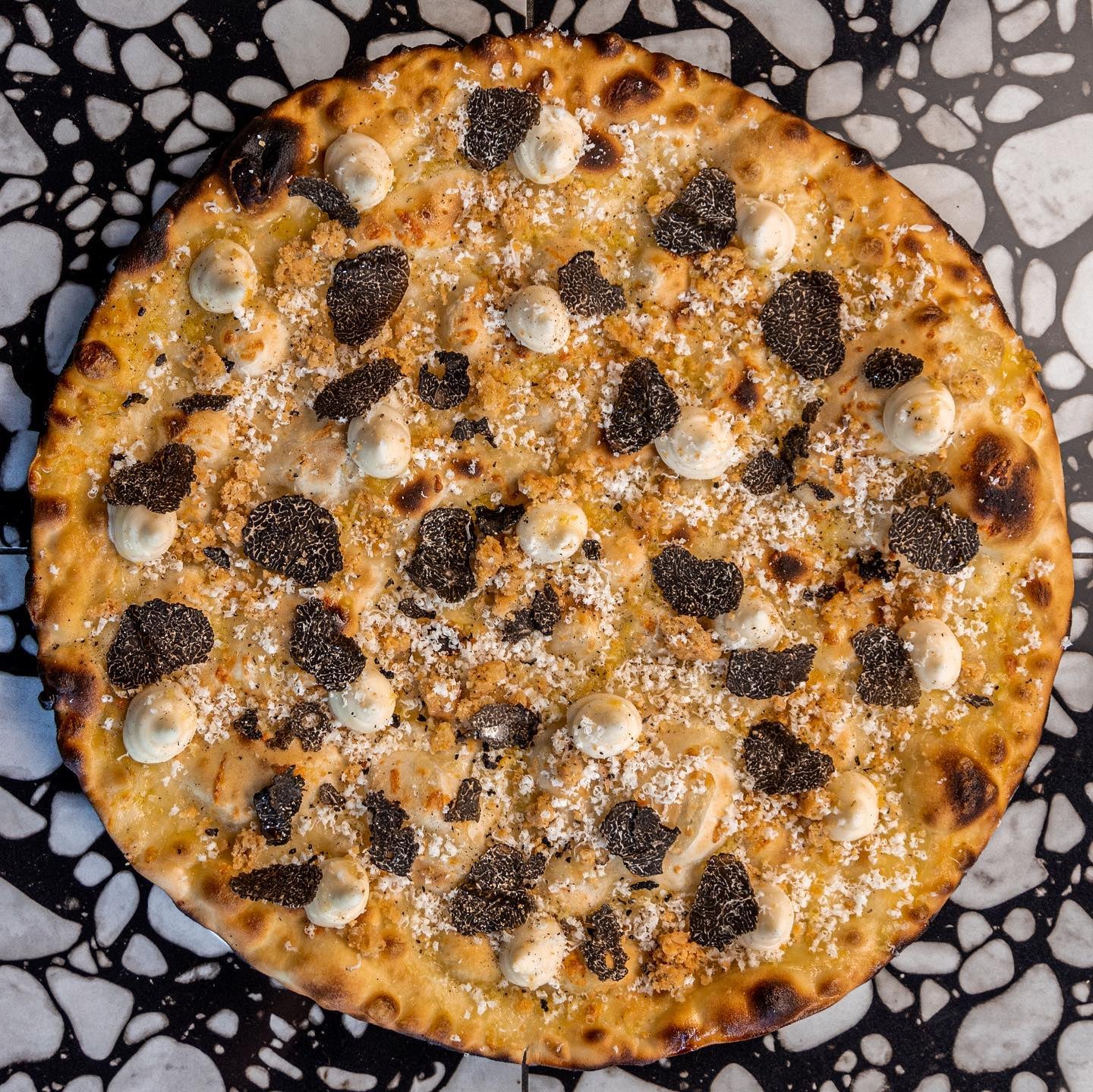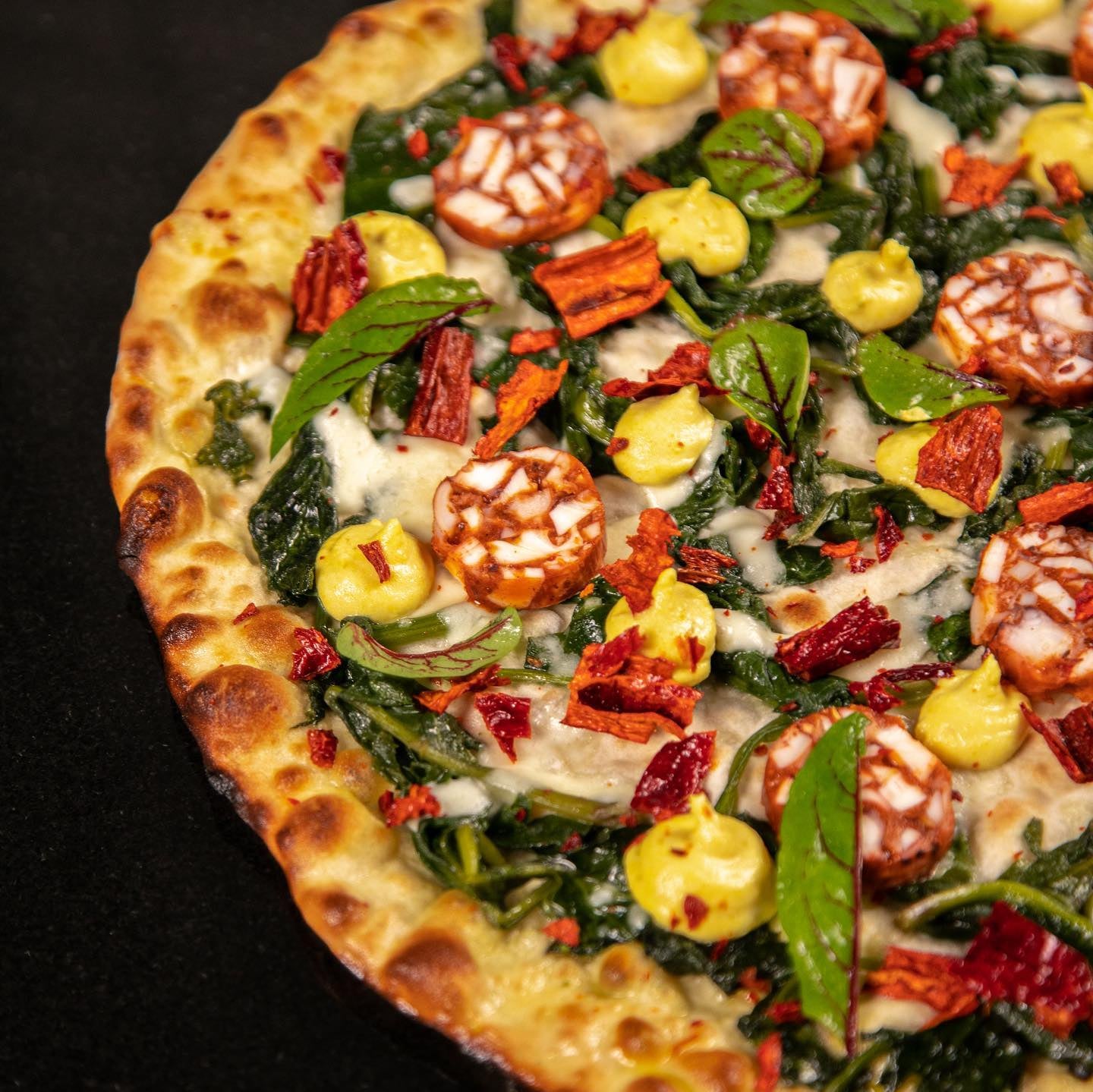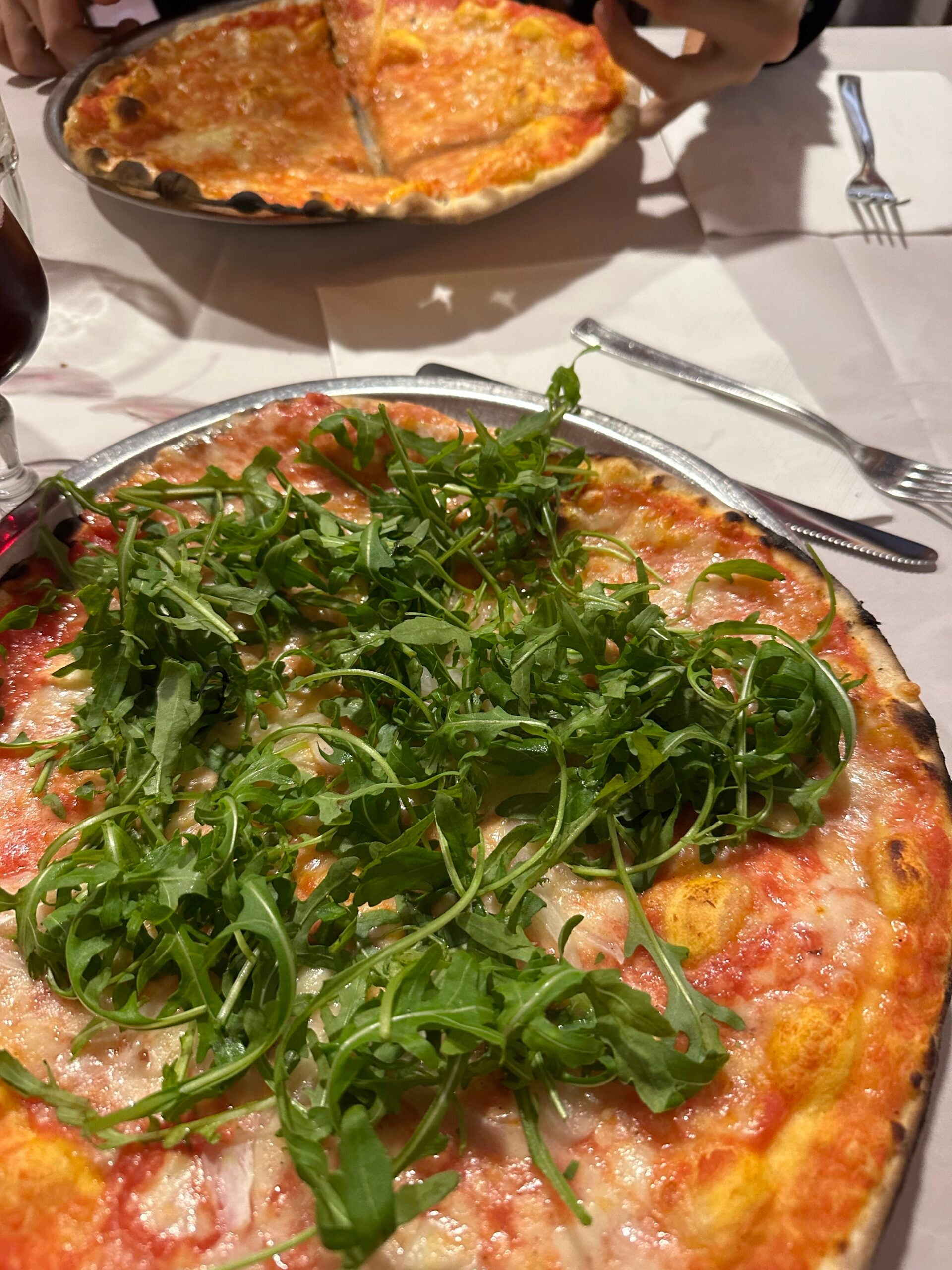
Romans call it “scrocchiarella” (translation: crunch), yet the legendary pie is moving beyond simply a signature texture.
I was ten years old when I tasted pizza for the first time. My family had moved to Rome in the middle of the school year, and my brother and I were dropped into a fancy private school improbably run by Irish nuns near Piazza di Spagna in the city’s Centro Storico (historic center). It was an abrupt introduction to Italian bourgeois culture, including the Italian pizza ritual. Every morning as we filed into class, we passed the school custodian selling neatly wrapped packets of pizza rossa and pizza bianca. In the classroom, we slid our paper-packaged snack in between the radiator columns to keep them warm until our midmorning break. I’m not sure if anything has ever tasted as delicious since.
Pizza bianca was a little basic, just straight dough and olive oil, so I always chose pizza rossa—yeasty, salty, and tangy with luscious canned Italian tomatoes (there were no go-to brands in those days). No cheese. Just the concentrated cooked tomatoes, salt, and a little spicy dried oregano. By break time, the pizza was slightly softened from the rich tomato topping and perfectly warm. Folded together, tomato side to tomato side, the outside crust slightly toasted by the radiator, it was a perfect contrast of soft and crisp.
This style of pizza, I quickly discovered, was available in neighborhood bakeries all over Rome, displayed freshly baked in five-foot lengths. Cut to any size you wanted and wrapped in paper, it was a perfect pick-me-up—not unlike the New York City slice or the Jamaican patty. To this day, it’s one of my favorite Roman snacks and one of the few things Italians won’t frown at you for eating in the street.
Back in 1975(!), pizza was not as ubiquitous in Italy as it is today, or as it was already in the United States. Of course, Naples was known for its historic style of pizza, but no one willingly went to that crime-ridden town. Rome had its own pizza styles: pizza rossa and bianca, of course, but also pizza al taglio, sold in specific shops with a thicker dough baked in a heavy sheet pan, topped with various ingredients like eggplant, mushroom, and the improbably delicious potato and rosemary, eaten by the slice and consumed while standing in the shop.

A new-ish Roman pizzeria, 180g (named for the weight of dough in each pizza), appears on most every list of superior pizzerias.
There were also true pizzerias, at least by our modern conception—places that were only open in the evening, where you went specifically to buy the 12-inch-round pies that were quickly cooked in blazing hot, wood-fired ovens. They were inexpensive places with paper tablecloths, cheap red and white wine, and bad beer, and they worked faster and harder than any other Italian eatery.
As teenagers, my friends and I frequented them for simple, quick food. One of the most famous was around the corner from where my family lived. Pizzeria Da Baffetto, it is called, for the owner’s luxuriant mustache. It was very popular, and it took courage to brave the lines of people waiting to get in, but once we became known, Baffetto himself would pull us in and seat us ahead of grumbling non-regulars so we could get our pizza fix.
All these pizzerias had similar menus: simple appetizers like plain or tomato bruschetta, or my favorite, melted mozzarella and anchovies. The pizza choices included everything from a basic marinara of tomatoes, olive oil, and dried oregano to “capricciosa,” with pickled artichokes, olives, anchovies, ham, and a raw egg dropped on to cook in the oven, although you could order any combination you fancied. My preference was basic—tomato sauce and mozzarella with shaved onions baked in, and fresh rughetta (arugula) scattered on top when it came out of the hot oven.
Roman pizza has a lot in common with the more famous Neapolitan style. But it has a flatter, crisper base that’s rolled out with a rolling pin rather than hand-stretched, giving it what Romans call “scrocchiarella” (crunch). It’s meant to be eaten with a knife and fork, although it’s also permissible to pick up a slice with your hands. Neapolitan pizza, on the other hand, is noted for its lighter, more tender and stretchy dough, made and shaped by hand from highly refined 0 or 00 flour. Moreover, it usually sports a cornicione, a thickened rim, that keeps its sauce from spilling out onto the oven floor. Both styles originated as fast, cheap food—the dough made and used quickly, the ingredients typically local and inexpensive.
But both are now experiencing a resurgence as pizza ripensata throughout the world, as smart pizzaioli play with superior ingredients, long fermentation of doughs made with high-quality flours, and novel combinations. Some are even making sweet dessert pizzas composed of cinnamon cream, apples, and pine nuts—which may sound weird but can be very, very good.
“So where and when does Roman pizza begin?” I asked Trapizzino chef/owner Stefano Callegari, famous in Rome and New York alike for his overstuffed Trapizzino sandwiches, though he actually started his career making thoughtful, well-regarded, Neapolitan-style pizza in Rome.
With cool Italian conviction, Stefano explained that ancient Romans served meals on thin, cracker-like bread instead of on plates. Once the patricians finished eating, the soggy remnants were fed to slaves. That struck me as a pretty wild supposition. When I looked askance at him, Stefano continued on to admit what I’d always thought: Roman pizza started in the postwar years when Italy was recovering, emotionally and economically, from its disastrous war and from Fascism. But what was happening in the modern pizza scene? On a recent visit to Rome this winter, I decided to test the ground for myself.
I began back at Pizzeria Da Baffetto on Via del Governo Vecchio near the Piazza Navona, which is on no modern list of the best pizzerias. In a jet-lagged haze, I ordered my old favorite and, to be honest, it was as good as I remembered: the onions were sweet, and the Roman rughetta, aggressively sharp, had lost none of its bite.
But as I neared the end and the pizza cooled, it went a bit flat, most likely because the ingredients were industrial and cheap, and I was horrified as I watched a waiter bring a bruschetta al pomodoro to a nearby table. It consisted of bread with thick slices of unadorned, pale, unripe tomatoes. Roman-style bruschetta al pomodoro should be made up of finely chopped tomato macerated in olive oil, salt, and garlic, all soaking into grilled or toasted bread.
Was the modern pizza ripensata going to be better? Pizza has always been quick, cheap food, never about refined technique or expensive ingredients. But I’d give it a try. Off I went to 180g (named for the weight of dough in each pizza), which appears on most every list of superior pizzerias. A bright, bustling place, it’s in a dreary neighborhood outside the city center; still, it was almost impossible to get a reservation. 180g improves on the classic Roman pizza formula by paying attention to technique (long fermentation that results in better flavor and texture) and ingredients.
Because this place is so bleedingly modern, I broke my rule and ordered a modern pizza combination: thinly sliced amberjack (a fish not dissimilar to tuna), bitter Roman greens, and a grape gelée. It was good, though I found that the fish overwhelmed the rest of the ingredients. I think I like the idea of innovative pizza better in theory than in practice. I eyed my kid’s much better margherita, vowing to order only pizza margherita for myself from now on. I loved what they were doing at 180g, admired their spirit, and relished their obvious success. But I wasn’t convinced their pizza was better than the old standards, and I wasn’t detecting much more flavor in the long-fermented dough made with superior flour.
“What’s the best Roman pizza?,” I asked everyone. From Stefano to my very Roman taxi driver, they all said: Pizzeria A Rota. So on my last night, I went there with my childhood best friend, Chiara, who still lives in the Casaletti Mattei neighborhood in the apartment she grew up in. We’ve eaten lots of pizza together over the years, although we’re too old now to get into the kind of trouble we did when we were kids.
Like 180g, A Rota is far out from the city center, but its location is charming, surrounded by old-fashioned small apartment buildings in a neighborhood where the cool artists priced out of the center have moved. The pizzeria, spare and unadorned, is owned by Sami El Sabawy, born in Rome to an Egyptian immigrant father who runs his own old-fashioned pizzeria. Sami does all the right modern stuff: long, slow fermentation of the dough, mixing it by hand, rolling it out with a rolling pin, and, while there are one or two slightly innovative pizzas on the menu, the focus is really on making the classics well.
This time I didn’t stray from those classics. I ordered the margherita, made with mozzarella and tomato, even though I sort of wanted Chiara’s pizza, a margherita with anchovies. The appetizers were classic Roman fritti, the supplì made with tomato rice wrapped around melting mozzarella that pulled apart when it broke open.
There was also a memorable mozzarella in carrozza—mozzarella wedged between two pieces of bread, dipped in egg and bread crumbs, then deep-fried. And the pizza was absolutely perfect, the dough crisp and flat but with enough flavor that, even as I came to the cooling end, I still wanted more because it tasted really good, the use of quality ingredients making the flavors last longer.
When I talked with Sami as he stood in the shop’s kitchen, he confirmed what I thought and what Stefano had told me: that pizza romana dates from the postwar era in Rome. It was made quickly because it was meant to be easy and cheap, the dough mixed and formed in the afternoon for evening service. What Sami was most interested in, he told me, was sticking to the Roman tradition but upgrading the technique, with great flour and long fermentation, letting his dough rise overnight and sourcing the best mozzarella, olive oil, and tomatoes, ingredients that can be distressingly commercialized but also critical to success. He’s not so interested in wildly creative combinations and reinventing the wheel. He just wants to make great pizza, he says, within the parameters of pizza’s long history.
And while I tried a piece of Chiara’s pizza with anchovies, I was pleased I’d stuck to my guns, because there is really only one pizza, and “margherita” is its name.

